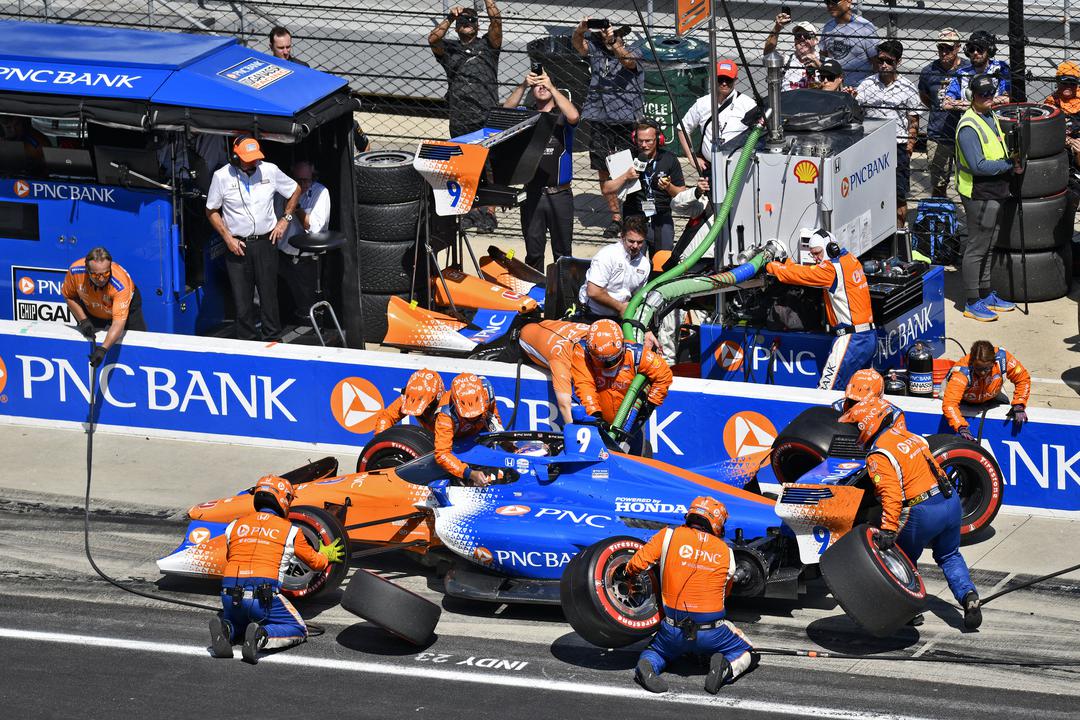

Scott Dixon’s plan for the Gallagher Grand Prix on Saturday at the Indianapolis Motor Speedway road course was simple.
Start on the black sidewall primary compound tyres, put on the preferred red sidewall alternate compound tyres, and run the rest of the 85-lap race with his remaining allotment of red tyres that provide more grip at the expense of longevity.
An early caution flag would make Dixon’s strategy work better. That exact situation helped Graham Rahal move through the field at the IMS road course race in May to finish 10th after a collision made the Ohio native pit for new tyres, dropping him to 24th for the early restart.
As the 27-car field made their way to Turn 7 on the first of 85 laps, Alex Palou attempted to overtake Alexander Rossi, Marcus Armstrong, and Felix Rosenqvist at the same time. Had Palou committed to the move and made it stick, the IndyCar Series points leader would have moved from eighth to fifth.
Instead, Palou decided to back out of the move, but not enough to avoid some light contact with Armstrong’s left-rear tyre. That contact spun the #11 Chip Ganassi Racing Honda, causing Palou to hit the brakes to avoid hitting the spinning rookie.
Dixon likewise hit the brakes, but Romain Grosjean immediately behind Dixon could not see the spinning Armstrong, tapping the #9 CGR Honda and causing it to spin.
Dixon kept his engine running and got out of the grass, but now he was mired deep in the field. Because Josef Newgarden hit Armstrong’s car and stalled his engine, race control called for a full course yellow.
The plan was to pit early. The plan was to get off the primary compound. The plan, however, did not involve Dixon spinning on the first lap.
“We were going to pit. We were going to kind of try the two-stop early anyway,” Dixon said in the post-race press conference.
“The difference being we were on the black tyre, we kind of wanted to get rid of the black tyre pretty quickly. Hoping to have great faith that the red [tyre] was actually going to last, and it did.
“I knew we weren’t out of it at that point, because if anybody tried to do the two-stop, you could still win the race from that period.”
Dixon pitted at the end of Lap 5 for a set of new red alternate tyres and set off on trying to make the strategy work from 23rd place on the Lap 7 restart.
The six-time IndyCar Series champion moved up to 20th place before green flag pit stops began at the end of Lap 13.
By the time the rest of the field made their first green flag pit stops, Dixon cycled to the lead, over six seconds ahead of Grosjean. Pitting at the end of Lap 32 dropped Dixon down to 14th.
After one pit stop sequence, Dixon gained nine total positions. Three laps after Dixon’s first green flag pit stop, the second pit sequence began.
When Christian Lundgaard pitted at the end of Lap 52, Dixon assumed the lead again with a little over six seconds in hand over Rahal in second place.
It was during this stint that Dixon figured that a win was possible.
“[Rahal] was behind me where it pops up on my dash that he’s the next car,” Dixon said.
“We had a like a six-second lead. I kept looking at it, running the lap times. He wasn’t gaining on us. This is crazy, this might actually work out.
“That was my first ‘aha’ moment where I’m like we’re definitely in a strong position here to pull that off.”
Seven laps after Lundgaard pitted, Dixon pitted for the final time. Dropping to 12th was not a concern, as the rest of the field couldn’t make it all the way to the end of the race.
Dixon blended out just over 31 seconds behind Rahal, who pitted for the final time at the end of Lap 63. After the #15 Rahal Letterman Lanigan Racing Honda left the pits, Dixon’s lead was around seven seconds.
While Rahal put on a used set of the red sidewall tyres, Dixon still had a new set of the alternate compound tyres left over after not advancing past the first round of qualifying, which he used to set his personal best lap of the race on Lap 61.
However, that charge meant that Dixon had to push those tyres hard to set that lap time, reducing their grip toward the end of the race. This helped Rahal slowly reduce Dixon’s lead as the pair circled the 14-turn, 2.439-mile road course.
“I think it was just my mistake for pushing so hard at the start of that stint and kind of hurt the tyre, otherwise I think it wouldn’t have been too difficult,” Dixon said of maintaining his lead late in the race.
“Even in the second-to-last stint, we were on used reds. We were able to maintain the gap to Graham or actually pull away. So I figured, once we get to the new tyres, we can really go. That was not the right thing to do.
“Yeah, we made a show of it. [Rahal] was coming fast, man. It would have been interesting. I think once he got to us, it was going to be very tough to pass. We had similar overtake. Yeah, the 9 car would have been very wide.”
Lapped traffic held both Dixon and Rahal up near the end of the race, with Dixon benefitting from Ryan Hunter-Reay keeping Rahal behind him for over a full lap as the race drew toward its conclusion.
Dixon’s lead shrank to as little as a quarter of a second, but try as he might, Rahal could not find a way into victory lane as an elated Dixon was able to extend of streak of scoring at least one win per season to 19 years.
“Feels damn good to get this win,” Dixon said. “Feel sorry for Graham. But, yeah, this is cool.”





















Discussion about this post